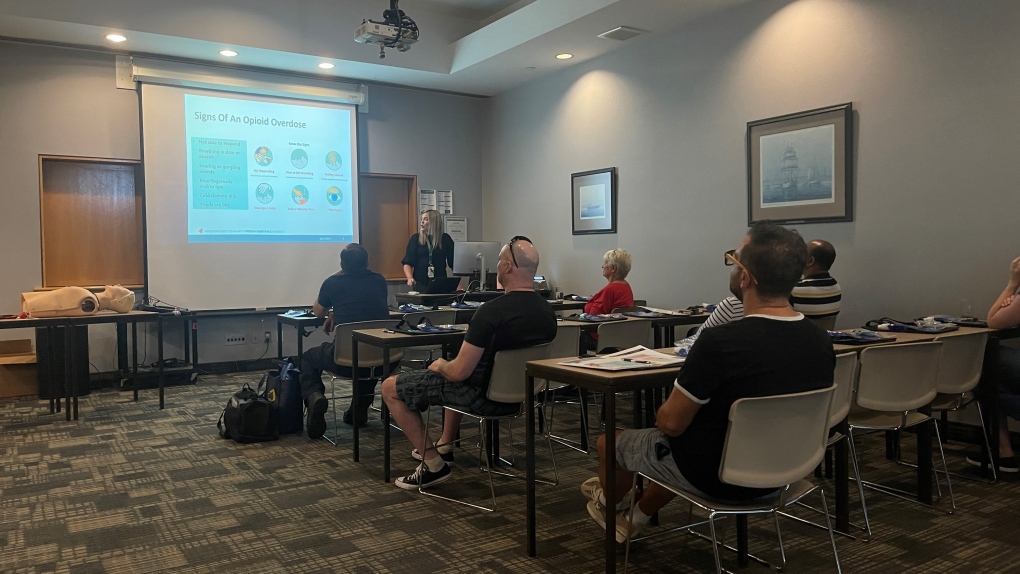Opioid crisis drives Windsor residents to learn naloxone use
Windsor residents are stepping up to combat the ongoing opioid crisis by learning how to use naloxone—a life-saving tool in overdose situations.
Janet Magrum lives in Windsor’s downtown core, right on the frontlines of the city’s battle against a rise in opioid overdoses.
"I sit outside the front of my house a lot, and I’ve had it happen on my front lawn," Magrum said, recalling how close the crisis has hit to home.
With eight opioid alerts issued by the Windsor-Essex County Health Unit so far this year—the same number issued in all of 2023—Magrum joined dozens of others at a naloxone training course, driven by a desire to be prepared.
"I just like to help the community and I live right in the middle of it," she explained.
The training session, hosted by the health unit in partnership with the City of Windsor, Windsor Police Service, and Essex-Windsor EMS, was part of a larger effort to empower residents with the knowledge to intervene during an overdose.
Some, like Magrum, came out on their own while others were encouraged by downtown businesses.
 Windsor residents participated in a course to learn how to properly administer naloxone to a person experiencing a drug overdose on Aug. 21, 2024. (Travis Fortnum/CTV News London)
Windsor residents participated in a course to learn how to properly administer naloxone to a person experiencing a drug overdose on Aug. 21, 2024. (Travis Fortnum/CTV News London)
"This training was offered to me by my workplace, so I wanted to take advantage of it," said Julie Tucker, another participant. "I want to be there for community members if they're in a crisis."
The session included three classes held on Wednesday, each focusing on when and how to use naloxone or Narcan, a nasal spray that can reverse the effects of an opioid overdose.
Jennifer Bradt, the chronic disease and injury prevention manager at the health unit, emphasized the importance of making naloxone kits accessible.
"Generally, there’s been an increase in opioid overdoses within our community. So, you know, it’s really important just to have kits out there and available to increase confidence,” she said.
Experts list five stages for those using naloxone to reverse the effects of a suspected overdose:
- Shout & Shake: Attempt to wake the person
- Call 911
- Administer the naloxone nasal spray by pushing the plunger all the way down to deliver the medication
- If you’re trained in CPR, perform chest compressions while waiting two to three minutes for the naloxone to take effect
- If there’s no response after the first dose, administer a second dose and continue CPR until emergency crews arrive
Magrum, after completing the training, felt better prepared.
"I can’t say I feel safer, but I feel better prepared to live in the neighborhood I live in," she said.
The health unit has hosted these training sessions before and plans to offer them again in the future. Dates and times will be announced as they are scheduled.
For more information on where to find and how to use a naloxone kit, visit the Windsor-Essex County Health Unit's website.
CTVNews.ca Top Stories

Quebec man, 81, gets prison sentence after admitting to killing wife with Alzheimer's disease
An 81-year-old Quebec man has been sentenced to prison after admitting to killing his wife with Alzheimer's disease.
Canada Post quarterly loss tops $300M as strike hits second week -- and rivals step in
Canada Post saw hundreds of millions of dollars drain out of its coffers last quarter, due largely to its dwindling share of the parcels market, while an ongoing strike continues to batter its bottom line.
'Immoral depravity': Two men convicted in case of frozen migrant family in Manitoba
A jury has found two men guilty on human smuggling charges in a case where a family from India froze to death in Manitoba while trying to walk across the Canada-U.S. border.
Prime Minister Trudeau attends Taylor Swift's Eras Tour in Toronto with family
Prime Minister Justin Trudeau is a Swiftie. His office confirmed to CTV News Toronto that he and members of his family are attending the penultimate show of Taylor Swift's 'The Eras Tour' in Toronto on Friday evening.
Trump supporters review-bomb B.C. floral shop by accident
A small business owner from B.C.'s Fraser Valley is speaking out after being review-bombed by confused supporters of U.S. president-elect Donald Trump this week.
Pat King found guilty of mischief for role in 'Freedom Convoy'
Pat King, one of the most prominent figures of the 2022 'Freedom Convoy' in Ottawa, has been found guilty on five counts including mischief and disobeying a court order.
Nearly 46,000 electric vehicles recalled in Canada over power loss risk
Nearly 46,000 electric vehicles from Kia, Hyundai and Genesis are being recalled in Canada over a potential power loss issue that can increase the risk of a crash.
Trump chooses Bessent to be Treasury secretary and Vought as top budget official
President-elect Donald Trump announced Friday that he'll nominate hedge fund manager Scott Bessent, an advocate for deficit reduction, to serve as his next treasury secretary. Trump also said he would nominate Russel Vought to lead the Office of Management and Budget.
Canada's tax relief plan: Who gets a cheque?
The Canadian government has unveiled its plans for a sweeping GST/HST pause on select items during the holiday period. The day after the announcement, questions remain on how the whole thing will work.


































